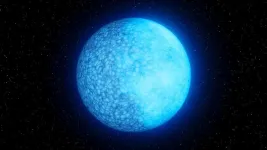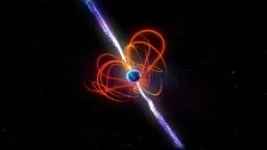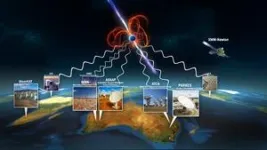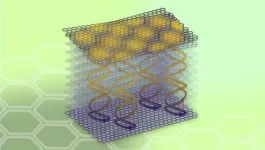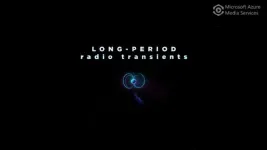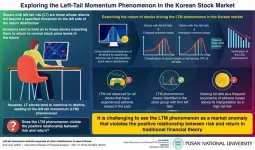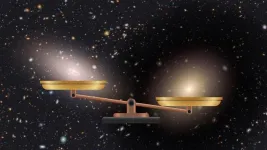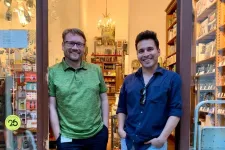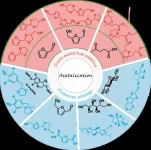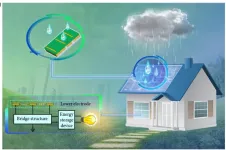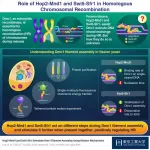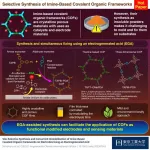(Press-News.org)
In a first for white dwarfs, the burnt-out cores of dead stars, astronomers have discovered that at least one member of this cosmic family is two faced. One side of the white dwarf is composed of hydrogen, while the other is made up of helium.
“The surface of the white dwarf completely changes from one side to the other,” says Ilaria Caiazzo, a postdoctoral scholar at Caltech who leads a new study on the findings in the journal Nature. “When I show the observations to people, they are blown away.”
White dwarfs are the scalding remains of stars that were once like our sun. As the stars age, they puff up into red giants; eventually, their outer fluffy material is blown away and their cores contract into dense, fiery-hot white dwarfs. Our sun will evolve into a white dwarf in about 5 billion years.
The newfound white dwarf, nicknamed Janus after the two-faced Roman god of transition, was initially discovered by the Zwicky Transient Facility (ZTF), an instrument that scans the skies every night from Caltech’s Palomar Observatory near San Diego. Caiazzo had been searching for highly magnetized white dwarfs, such as the object known as ZTF J1901+1458, which she and her team found previously using ZTF. One candidate object stood out for its rapid changes in brightness, so Caiazzo decided to investigate further with the CHIMERA instrument at Palomar, as well as HiPERCAM on the Gran Telescopio Canarias in Spain’s Canary Islands. Those data confirmed that Janus is rotating on its axis every 15 minutes.
Subsequent observations made with the W. M. Keck Observatory atop Maunakea in Hawaiʻi revealed the dramatic double-faced nature of the white dwarf. The team used an instrument called a spectrometer to spread the light of the white dwarf into a rainbow of wavelengths that contain chemical fingerprints. The data revealed the presence hydrogen when one side of the object was in view (with no signs of helium), and only helium when the other side swung into view.
What would cause a white dwarf floating alone in space to have such drastically different faces? The team acknowledges they are baffled but have come up with some possible theories. One idea is that we may be witnessing Janus undergoing a rare phase of white dwarf evolution.
“Not all, but some white dwarfs transition from being hydrogen- to helium-dominated on their surface,” Caiazzo explains. “We might have possibly caught one such white dwarf in the act.”
After white dwarfs are formed, their heavier elements sink to their cores and their lighter elements—hydrogen being the lightest of all—float to the top. But over time, as the white dwarfs cool, the materials are thought to mix together. In some cases, the hydrogen is mixed into the interior and diluted such that helium becomes more prevalent. Janus may embody this transition phase, but one pressing question is: why is the transition happening in such a disjointed way, with one side evolving before the other?
The answer, according to the science team, may lie in magnetic fields.
“Magnetic fields around cosmic bodies tend to be asymmetric, or stronger on one side,” Caiazzo explains. “Magnetic fields can prevent the mixing of materials. So, if the magnetic field is stronger on one side, then that side would have less mixing and thus more hydrogen.”
Another theory proposed by the team to explain the two faces also depends on magnetic fields. But in this scenario, the fields are thought to change the pressure and density of the atmospheric gases.
“The magnetic fields may lead to lower gas pressures in the atmosphere, and this may allow a hydrogen ‘ocean’ to form where the magnetic fields are strongest,” says co-author James Fuller, professor of theoretical astrophysics at Caltech. “We don’t know which of these theories are correct, but we can’t think of any other way to explain the asymmetric sides without magnetic fields.”
To help solve the mystery, the team hopes to find more Janus-like white dwarfs with ZTF’s sky survey. “ZTF is very good at finding strange objects,” Caiazzo says. Future surveys, such as those to be performed by the Vera C. Rubin Observatory in Chile, she says, should make finding variable white dwarfs even easier.
The study, titled “A rotating white dwarf shows different compositions on its opposite faces,” was funded by Caltech’s Walter Burke Institute for Theoretical Physics, the European Research Council, The Leverhulme Trust, and the United Kingdom’s Science and Technology Facilities Council.
Observations from NASA’s Neils Gehrels Swift Observatory—renamed after Gehrels, a Caltech alumnus (PhD ’82) who passed away in 2017—were also used in the study to help narrow down the temperature of the object to a searing 35,000 Kelvin (roughly 35,000 degrees Celsius).
Caltech’s ZTF is funded by the National Science Foundation and an international collaboration of partners. Additional support comes from the Heising–Simons Foundation and from Caltech. ZTF data are processed and archived by IPAC, a science and data center for astronomy at Caltech. NASA supports ZTF’s search for near-Earth objects through the Near-Earth Object Observations program.
END
FROM: James Urton
University of Washington
206-543-2580
jurton@uw.edu
(Note: researcher contact information at the end)
Embargoed by Nature
For public release at 11 a.m. Eastern Time (8 a.m. Pacific Time; 4 p.m. British Summer Time) on Wednesday, July 19, 2023
Researchers put a new twist on graphite
For decades, scientists have been probing the potential of two-dimensional materials to transform our world. 2D materials are only a single layer of atoms thick. Within them, subatomic particles like electrons can only move in two dimensions. This simple restriction can trigger unusual electron behavior, ...
In our modern era of larger, more destructive, and longer-lasting fires—called the Pyrocene—plants and animals are evolving quickly to survive. By synthesizing the wide body of research about rapid animal evolution in response to fire in a review publishing in Trends in Ecology & Evolution on July 19, a multidisciplinary team of ecology experts hopes to leverage what we already know to help foster evolution-informed conservation plans. In this way, they suggest, we can try to harness the ways in which fire impacts animals to protect vulnerable species—working with evolution instead of against it.
In response to climate change and changes in land use, ...
An international team led by astronomers from the Curtin University node of the International Centre for Radio Astronomy Research (ICRAR) has discovered a new type of stellar object that challenges our understanding of the physics of neutron stars.
The object could be an ultra-long period magnetar, a rare type of star with extremely strong magnetic fields that can produce powerful bursts of energy.
Until recently, all known magnetars released energy at intervals ranging from a few seconds to a few minutes. The newly discovered object emits radio waves every 22 minutes, making it the longest period magnetar ever detected.
The research was published ...
Left-tail risk (LT) stocks are those whose returns fall into the extreme end on the left side of the return distribution. In the hopes of mean-reverting to the normal price, investors usually hold on to these stocks. However, contrary to mean-reverting expectations, these stocks that have experienced extreme losses and high tail risks in the past tend to continue declining in the future, resulting in financial losses. This phenomenon, referred to as left-tail momentum (LTM), appears to challenge the traditional notion of a positive relationship between risk and return.
To investigate this market anomaly, a team of researchers, led by Prof. Eom from the School of Business at Pusan National ...
A team of scientists, led by the researcher at the IAC and the University of La Laguna (ULL) Sebastién Comerón, has found that the galaxy NGC 1277 does not contain dark matter.This is the first time that a massive galaxy (it has a mass several times that of the Milky Way) does not show evidence for this invisible component of the universe. “This result does not fit in with the currently accepted cosmological models, which include dark matter” explains Comerón.
In the current standard model cosmology massive galaxies contain substantial quantities of dark matter, a type of matter which does not interact in the same ...
Finding sustainable and clean fuels is crucial in today’s global energy and climate crisis. One promising candidate that is increasingly gaining relevance is hydrogen. However, today’s industrial hydrogen production still has a considerable CO2 footprint, especially considering processes like steam reforming or non-sustainable electrolysis.
A team led by Prof. Dominik Eder from the Institute of Materials Chemistry (TU Wien) is therefore focusing on the development of environmentally friendly processes for obtaining hydrogen, for example by photocatalysis. This process enables the conversion of ...
Biomass, mainly composed of lignocellulose and vegetable oil, has been acclaimed as one of the most promising sustainable sources of raw carbon material for the synthesis of transport fuels and value-added chemicals. The catalytic conversion of lignocellulose/vegetable oil and their related derivatives has attracted great attention in biomass valorization. Many elegant methods including hydrolysis, dehydration, hydrogenation, hydrogenolysis, oxidation, etherification, esterification, amination, aldol condensation, ...
When raindrops fall from the sky, they can produce a small amount of energy that can be harvested and turned into electricity. It is a small-scale version of hydropower, which uses the kinetic energy of moving water to produce electricity. Researchers have proposed that the energy collected from raindrops could be a potential source of clean, renewable power. However, this technology has been difficult to develop on a large scale, which has limited its practical application.
To collect raindrop energy, a device called a triboelectric ...
Homologous recombination (HR) is an important process that plays multiple crucial roles during meiosis, a type of cell cycle dedicated to sexual reproduction. During HR, homologous DNA molecules exchange their genetic material. During the meiotic prophase, DNA are clipped throughout the genome, forming numerous DNA double-strand breaks. Such DNA breaks attract homologous recombination enzymes, which promote pairing of homologous chromosomes.
Dmc1 is one such meiosis-specific recombinase in eukaryotes (organisms that have a clearly defined nucleus), ...
Covalent organic frameworks (COFs) are versatile materials composed of interconnected organic molecules held together by covalent bonds. These frameworks can be constructed in two-dimensional or three-dimensional (3D) forms which possess a unique combination of low density, high surface area, and easily tunable properties. Among the various types of COFs, imine-linked COFs have garnered considerable attention owing to their exceptional thermal and chemical stability as well as their broad scope of monomeric starting materials.
However, traditional bulk synthetic methods for COFs often yield powders that are insoluble ...
